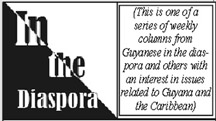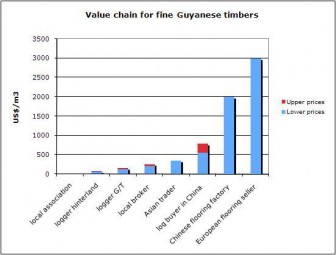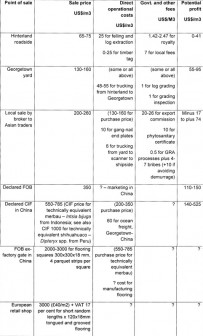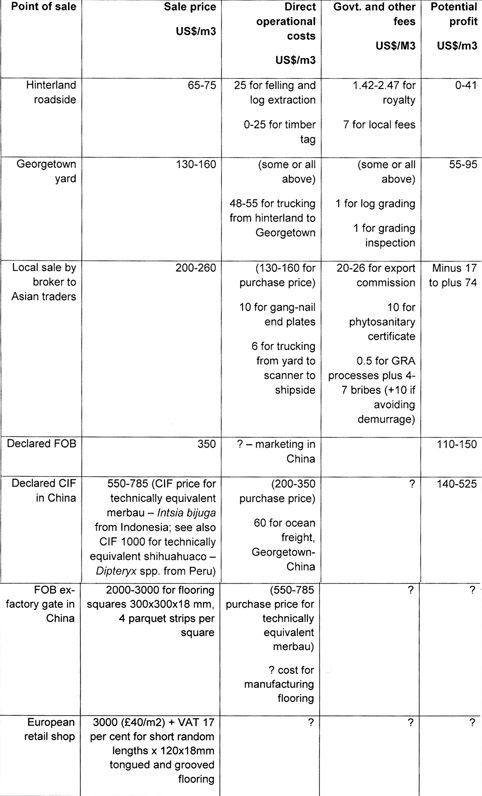By Janette Bulkan
In the second article in this series ‘The rule of law – inefficiency and corruption in the export of timber logs to Asia’ published by Stabroek News on 30 January 2012, I showed how a non-systematic approach by government agencies added to business costs and opened doors to corrupt and illegal practices. This followed the first article ‘The rule of law? – not in the forest sector of Guyana’ published by Stabroek News’ In the Diaspora on Monday 16 January 2012, in which I outlined the simple ways by which some traders export timber logs illegally. In this third article, I trace the change in price along the value chain towards the final consumer. It is entirely contrary to national policies, from the National Development Strategy of 1995-7 onwards, for these fine timbers to be given away at such low prices to Asian countries instead of converted into high-value-added products here in Guyana. The government agencies and their Boards – Guyana Forestry Commission, Guyana Revenue Authority, Go-Invest – are at best culpably negligent.

The National Constitution states ‘The goal of economic development includes the objective of creating, promoting and encouraging an economic system capable of achieving and maintaining sustainable competitive advantage in the context of a global competitive environment, by fostering entrepreneurship, individual and group initiative and creativity, and strategic alliances with domestic and global business partners in the private sector‘ (Article 14) and ‘The goal of economic development includes the objective of laying the material basis for the greatest possible satisfaction of the people’s growing material, cultural and intellectual requirements, as well as the dynamically stable development of their personality, creativity, entrepreneurial skills, and cooperative relations in a plural society . . .’ (Article 15).


Using the GFC’s current estimate of log production cost (23 January 2012) as US$100 and a value multiplier of 14.6 for log-to-furniture – that is, using technology already familiar to and installed in Guyana – those half-million m3 of logs could have been processed in Guyana to furniture worth over US$734 million. So how is the value actually being captured? Here are some estimates based on interviews in December 2011 and January 2012, all expressed in US dollars per cubic metre for the flooring-quality timber wamara (Swartzia leiocalycina) and closely related itikiboraballi (three other species of Swartzia). Wamara is a species endemic to Guyana and for which therefore Guyana should have been a price-maker rather than a price-taker.

The most striking feature of the graph and table is the very small amount of revenue captured for the nation of Guyana. The largest single item is the GFC export commission, still only 10 per cent of declared FOB value in 2011, when the excess profits being captured by the log traders are clearly very large; as pointed out by Mahadeo Kowlessar in 2007 (Stabroek News letter, 04 July 2007, ‘Guyana would do better to process logs rather than ship them out unprocessed’). This is and has been an easily corrected fault but the political will of the GFC and GRA appears to be lacking.
The GFC has pointed out, in the context of current discussions on revision of the log export policy, that there is no absolute shortage of bank liquidity or credit, and that tooling up for the elements of a more modern forest industry is not very expensive. The GFC and GRA however are not acknowledging the major barriers to investment. These include the arbitrary and discriminatory way in which Go-Invest investment subsidies are granted or refused; the lack of collateral caused by the short-term approach to forest concessions (25-year Timber Sales Agreements actually treated by the GFC as annual licences); petty hassling by police and GFC staff of timber trucking; the arbitrary and discriminatory application of GFC penalties for minor infractions; the sheer amount of running around to collect approvals and signatures from GFC and GRA staff who disappear from their desks, and to provide transport and lunches and ‘small pieces’ to government staff at several levels.
Under these discouragements, is it surprising that loggers sell prime timbers at low prices to Asian buyers with suitcases full of cash, just to avoid the inconveniences and uncertainties of Guyana’s bureaucracy? Yes, the private sector should and could do more, but it is the political leadership and the government agencies which have a constitutional obligation to provide the level playing field for investors, national and foreign. There is no lack of consultancy advice on what is needed. There is a real shortage of political commitment to fair and rational application of national policies. This ought to be a positive incentive for a new political administration to break from two decades of overt corruption.

